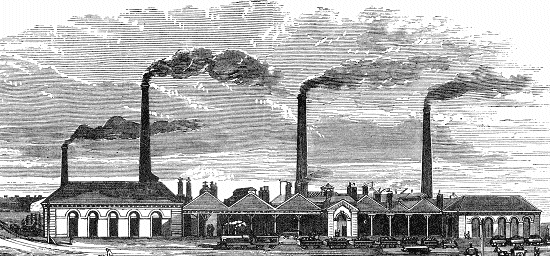|
Ahead was the railway bridge
over Lower Horseley Fields. Even more tall chimneys
could be seen to the left above the railway
embankment. As the traveller passed through the
railway bridge another impressive display of
flickering red, orange, and black dominated the
scene. This was the Shrubbery Iron Works, where a
circle of puddling furnaces and tall chimneys
greeted the visitor. Dark figures could be seen
darting around the furnaces, sometimes disappearing
into the black of the night.
As the traveller crossed the
steep Horseley Fields canal bridge a final spectacle
would come into sight on the left. This was Isaac
Jenks’ famed Minerva Iron and Steel Works with 21
puddling furnaces and 4 tall chimneys. The road
would shake and vibrate as the forges operated, and
deep thuds would be heard for some distance around.

Another iron works. This one
is has a lot of railway sidings.
Imagine the daily scene on the
canal. Large amounts of coal, limestone, and iron
ore would arrive at the works, where gangs of men
unloaded the boats and stacked the raw materials
into neat piles. Others would be loading the iron
pigs, iron products, and iron and steel plate into
waiting boats to be taken away. The canal would be
like a modern busy road, except that everything
happened at a much slower pace.
Depression in the Iron Trade
In the late 1870s there was a
deep depression in the iron trade. At the time John
Jones was mayor of Wolverhampton. The terrible
effect on the local population is described as
follows, in William Highfield Jones’ book “Story of
the Municipal Life of Wolverhampton”. The events
possibly took place in the winter of 1879:
While Mr.
Jones was Mayor, a season of bad trade set in, which
caused distress among the labouring classes. The
depression was specially felt in the iron making
industry of the district, and brought on a crisis.
Firms hitherto of good repute failed to meet their
engagements, among these the Chillington Iron Works,
the Parkfield Colliery Company, and several others.
The
largest and most important firm in the town was G.
B. Thorneycroft & Company. The partners in this
firm, finding they could not continue making iron
except at a great loss, determined to close their
works. This was a great blow to the iron workers.
Besides this, many of the blast furnaces around were
blown out, and the ironworks in the district were
silent. Hundreds of decent men wandered about unable
to find work.
In
addition to these troubles, on January 12th
a heavy fall of snow came down, followed by a severe
frost, which continued until the end of March. The
frost put an entire stop to building operations and
all kinds of outdoor employment. The effect was soon
felt, and in a short time thousands of families were
on the point of starvation. Every day crowds of
hungry labouring men could be seen blocking up the
thoroughfares opposite the Town Hall, North Street,
and the Union Workhouse on the Bilston Road, all
clamouring for work or bread.
The Mayor
showed great energy in dealing with the emergency.
He opened a relief fund, and appealed to the public
for subscriptions. His appeal was generously
responded to, and he instantly organised centres for
the distribution of bread, oatmeal, coals, etc. In
addition soup kitchens were opened in different
parts of the borough to help the women and children.
The members of the town council organised themselves
into ward committees and distributed tickets for
relief in a systematic manner. The Guardians of the
Poor did their utmost to mitigate the suffering.
All signs of this once great
industry have now disappeared. The original
factories have long-gone and been replaced with
others. As Horseley Fields is one of Wolverhampton’s
main eastern arteries, large numbers of people
travel along it every day. Very few of them know of
the important industry that once flourished there. |